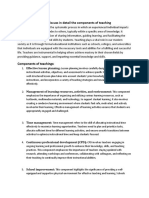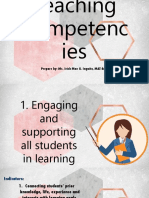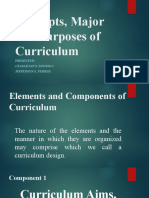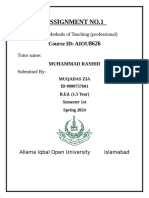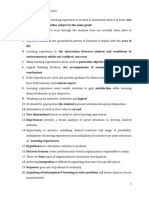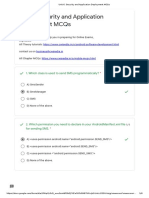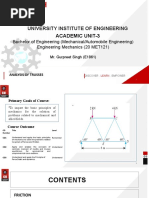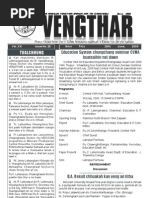0 ratings0% found this document useful (0 votes)
2 viewsDocument (2)402
Document (2)402
Uploaded by
dingdrop7Copyright:
© All Rights Reserved
Available Formats
Download as DOCX, PDF, TXT or read online from Scribd
Document (2)402
Document (2)402
Uploaded by
dingdrop70 ratings0% found this document useful (0 votes)
2 views5 pagesCopyright
© © All Rights Reserved
Available Formats
DOCX, PDF, TXT or read online from Scribd
Share this document
Did you find this document useful?
Is this content inappropriate?
Copyright:
© All Rights Reserved
Available Formats
Download as DOCX, PDF, TXT or read online from Scribd
Download as docx, pdf, or txt
0 ratings0% found this document useful (0 votes)
2 views5 pagesDocument (2)402
Document (2)402
Uploaded by
dingdrop7Copyright:
© All Rights Reserved
Available Formats
Download as DOCX, PDF, TXT or read online from Scribd
Download as docx, pdf, or txt
You are on page 1of 5
1.
Principles of Learning Experience
Active Participation: Learning is more effective when students are actively
engaged.
Relevance: Experiences should relate to the learner's interests and goals.
Reinforcement: Feedback strengthens understanding and retention.
Transfer of Learning: Learning should be applicable to real-life situations.
Adaptability: Experiences must cater to diverse learner needs and contexts.
2. Learner-Centered Curriculum
A curriculum that focuses on the needs, interests, abilities, and experiences
of the learners, promoting active participation and personal growth.
3. Democratic Values
Equality: Ensuring fairness and equal opportunities for all learners.
Respect: Fostering mutual respect among peers and teachers.
Freedom: Encouraging critical thinking and the freedom to express ideas.
Responsibility: Teaching accountability within a collaborative environment.
4. Source Plan
A comprehensive blueprint for curriculum development, detailing objectives,
content, teaching methods, and evaluation strategies.
5. 3 Types of Curriculum
1. Formal Curriculum: The planned and structured content taught in schools.
2. Informal Curriculum: Learning through interactions and co-curricular
activities.
3. Hidden Curriculum: Unspoken or implicit lessons learned through culture
and behavior in schools.
6. Evaluation Procedure Steps
1. Define objectives and criteria.
2. Select appropriate evaluation tools and methods.
3. Collect and analyze data.
4. Provide feedback to students.
5. Reflect and revise teaching strategies.
7. Subject Specialist
A teacher or educator with in-depth knowledge and expertise in a particular
subject area, responsible for curriculum design and delivery.
8. Tyler Curriculum
Developed by Ralph Tyler, this model emphasizes four components:
1. Defining learning objectives.
2. Selecting learning experiences.
3. Organizing experiences.
4. Evaluating outcomes.
9. Criteria for Evaluation
Relevance to learning objectives.
Alignment with curriculum goals.
Fairness and reliability of methods.
Practicality and usability of results.
10. Why is there a need for evaluation in learning experiences?
To assess the effectiveness of teaching methods.
To measure student progress and understanding.
To identify areas for improvement in the curriculum.
To ensure alignment with educational goals and standards.
11. How can a teacher provide an educational experience?
Engage Students: Use interactive activities and discussions.
Connect with Real Life: Relate lessons to practical and real-world situations.
Encourage Exploration: Foster curiosity and critical thinking.
Use Varied Methods: Combine lectures, hands-on activities, and technology.
Provide Feedback: Offer constructive feedback to guide learning.
You might also like
- The Demands of Society From The Teacher As A ProfessionalDocument54 pagesThe Demands of Society From The Teacher As A ProfessionalJessa Yaun100% (31)
- Basic Fire Safety: Directorate of Fire and Emergency Services ST - Inez, Panaji-GoaDocument28 pagesBasic Fire Safety: Directorate of Fire and Emergency Services ST - Inez, Panaji-GoaSunita YadavNo ratings yet
- Lesson Plan AssismentDocument8 pagesLesson Plan AssismentkhalisaatyahayaNo ratings yet
- curriculummodelsDocument4 pagescurriculummodelstonyadmiral220No ratings yet
- Rational Models Ralph TylerDocument14 pagesRational Models Ralph TylerhnasdbsywnyNo ratings yet
- Chapter 4 ExDocument3 pagesChapter 4 ExShine H. DayonNo ratings yet
- 8601 Aiou assignmentDocument30 pages8601 Aiou assignmentMuqadas ZiaNo ratings yet
- Applied Knowledge of Content Within and Across Curriculum Teaching AreasDocument1 pageApplied Knowledge of Content Within and Across Curriculum Teaching AreasjernalynluzanoNo ratings yet
- Teaching Learning InteractionDocument30 pagesTeaching Learning InteractionjgareshNo ratings yet
- The Teacher in The Classroom and CommunityDocument67 pagesThe Teacher in The Classroom and CommunityTimoy Cajes100% (5)
- GROUP 5 WPS OfficeDocument18 pagesGROUP 5 WPS OfficeFrance PilapilNo ratings yet
- Quantitative AptitudeDocument15 pagesQuantitative AptitudeSandeep PalNo ratings yet
- Q.1. Define Teaching. Discuss in Detail The Components of TeachingDocument10 pagesQ.1. Define Teaching. Discuss in Detail The Components of TeachingZeeshan NasirNo ratings yet
- Unit 3 - Lessons 1 and 2-3Document27 pagesUnit 3 - Lessons 1 and 2-3Jhazmine Estrelle Y. IgartaNo ratings yet
- Prepare By: Ms. Irish Mae G. Inguito, MAT-EnglishDocument25 pagesPrepare By: Ms. Irish Mae G. Inguito, MAT-EnglishKrizia Mae D. PinedaNo ratings yet
- Teaching Strategies - ReviewerDocument5 pagesTeaching Strategies - RevieweraculawayNo ratings yet
- Nature and CharacteristicsDocument33 pagesNature and Characteristicsemmanuellearningcenter2023No ratings yet
- Obj 8Document5 pagesObj 8Jhay R QuitoNo ratings yet
- Objectives RpmsDocument6 pagesObjectives RpmsJacqui Auza LomotNo ratings yet
- 8601-1Document27 pages8601-1ruksana bibiNo ratings yet
- Edu 2 Chapter 7Document37 pagesEdu 2 Chapter 7Shane LouiseNo ratings yet
- Syllabus Field StudyDocument9 pagesSyllabus Field Studyjustine100% (2)
- fs 1 chapter 4Document13 pagesfs 1 chapter 4shanepaglicawanNo ratings yet
- Teaching MethodologiesDocument39 pagesTeaching Methodologieszafariqbalafridi1985No ratings yet
- T-Tess Six Educator StandardsDocument1 pageT-Tess Six Educator Standardsapi-351054075100% (1)
- The Learning Environment Is Supportive and ProductiveDocument8 pagesThe Learning Environment Is Supportive and Productiveasiano_24No ratings yet
- Code 8601Document12 pagesCode 8601عائشہ حسینNo ratings yet
- Concepts Nature and Purposes of CurriculumDocument36 pagesConcepts Nature and Purposes of Curriculumeljoy ferrerNo ratings yet
- Cognitivism in The ClassroomDocument23 pagesCognitivism in The ClassroomMichelle MalanaNo ratings yet
- Chapter 2 Teaching ProfessionDocument31 pagesChapter 2 Teaching ProfessionBryan TamayoNo ratings yet
- Feb Andaragogy Theory of Adult LearningDocument10 pagesFeb Andaragogy Theory of Adult LearningBrian RianNo ratings yet
- 8601 LABEEBDocument31 pages8601 LABEEBmohammad tahirNo ratings yet
- Principles and Methods in TeachingDocument108 pagesPrinciples and Methods in TeachingMOHAMMAD DATUGANNo ratings yet
- Group 2 Key PointersDocument6 pagesGroup 2 Key PointersDarlene EsmeraldaNo ratings yet
- Field StudyDocument7 pagesField StudyMikhaila TorrevillasNo ratings yet
- Raven EvalDocument5 pagesRaven Evalapi-312569506No ratings yet
- 8626-01-Muqadas ZiaDocument30 pages8626-01-Muqadas ZiaMuqadas ZiaNo ratings yet
- Monika Obs 1Document9 pagesMonika Obs 1api-311130965No ratings yet
- General Methods Of Teaching Assignment no1Document17 pagesGeneral Methods Of Teaching Assignment no1JawadNo ratings yet
- Final EvalutaionDocument6 pagesFinal Evalutaionapi-281365898No ratings yet
- Lordspringfinal 2015Document5 pagesLordspringfinal 2015api-273078766No ratings yet
- Teacher Competencies: 1. Knowledge of Students and Their DevelopmentDocument2 pagesTeacher Competencies: 1. Knowledge of Students and Their DevelopmentLeonardo Noran JrNo ratings yet
- 8601 - 2Document19 pages8601 - 2umerNo ratings yet
- 8601.Document26 pages8601.Zujaja AkramNo ratings yet
- Selecting Learning ExperiencesDocument34 pagesSelecting Learning Experiencesfreddo100% (2)
- Topics For LDocument2 pagesTopics For LMariela SamozaNo ratings yet
- Prof Ed 9 and 10Document11 pagesProf Ed 9 and 10Joshua ManaliliNo ratings yet
- Demands-of-Society-from-the-TeacherDocument7 pagesDemands-of-Society-from-the-TeacherMark SarmientoNo ratings yet
- Educ 55 Lesson 3Document28 pagesEduc 55 Lesson 3enojosa nhoelNo ratings yet
- Cbet Exam QuestionsDocument117 pagesCbet Exam QuestionsjoanmuthonikiharaNo ratings yet
- Uds WHAT IS QUALITY IN CLASSROOM LEARNING AND ITS UNDERSTANDINGDocument5 pagesUds WHAT IS QUALITY IN CLASSROOM LEARNING AND ITS UNDERSTANDINGRohit KeshriNo ratings yet
- Standards PresentationDocument12 pagesStandards Presentationapi-254267704No ratings yet
- Final Maggie Anderson 3 26 15Document5 pagesFinal Maggie Anderson 3 26 15api-280782218No ratings yet
- ANSWER-SHEET- edmondDocument5 pagesANSWER-SHEET- edmondsiredmond.lsaNo ratings yet
- FS4 NotesDocument7 pagesFS4 NotesPhetzz SurioNo ratings yet
- philosophical biased. Group 3Document7 pagesphilosophical biased. Group 3tonyadmiral220No ratings yet
- Concept of TeachingDocument7 pagesConcept of TeachingJeevesh ViswambharanNo ratings yet
- Elements of CurriculumwordDocument4 pagesElements of CurriculumwordCharlene PortugalNo ratings yet
- 8601 Important Questions M.JABERDocument22 pages8601 Important Questions M.JABERAbdul MajidNo ratings yet
- Classroom ManagementDocument3 pagesClassroom ManagementTahpehs PhiriNo ratings yet
- Document (1) 201Document5 pagesDocument (1) 201dingdrop7No ratings yet
- Finalterm Paper of Psy406Document1 pageFinalterm Paper of Psy406dingdrop7No ratings yet
- EDU402 Final-Term Syllabus PDFDocument53 pagesEDU402 Final-Term Syllabus PDFdingdrop7No ratings yet
- EDU101 3 Quiz#3 6 July2023 FINALS by MISS MEHWISH- Dwnld From (vusolutionpoint.com)Document4 pagesEDU101 3 Quiz#3 6 July2023 FINALS by MISS MEHWISH- Dwnld From (vusolutionpoint.com)dingdrop7No ratings yet
- EDU201 Unsloved Final Term Subjective QuestionsDocument1 pageEDU201 Unsloved Final Term Subjective Questionsdingdrop7No ratings yet
- EDU301 Final Term Subjective File by Tanveer Online AcademyDocument31 pagesEDU301 Final Term Subjective File by Tanveer Online Academydingdrop7No ratings yet
- 20 Percent Passing RuleDocument2 pages20 Percent Passing Ruledingdrop7No ratings yet
- Edu402-Objective-Final-Term-P2 (2)Document4 pagesEdu402-Objective-Final-Term-P2 (2)dingdrop7No ratings yet
- EDU301 Quiz 4 File by Tanveer Online AcademyDocument11 pagesEDU301 Quiz 4 File by Tanveer Online Academydingdrop7No ratings yet
- 2024 09 Masterclass WorkbookDocument32 pages2024 09 Masterclass Workbookdingdrop7No ratings yet
- 2024 09 Masterclass Shopping ListDocument1 page2024 09 Masterclass Shopping Listdingdrop7No ratings yet
- Solutions EDU402 2Document5 pagesSolutions EDU402 2dingdrop7No ratings yet
- Ascending With Both Feet On The GroundDocument188 pagesAscending With Both Feet On The Grounddingdrop7No ratings yet
- Fall 2024 - EDU201 - 1Document2 pagesFall 2024 - EDU201 - 1dingdrop7No ratings yet
- The Perfume of Silence (Francis Lucille (Lucille, Francis) ) (Z-Library)Document212 pagesThe Perfume of Silence (Francis Lucille (Lucille, Francis) ) (Z-Library)dingdrop7100% (1)
- Gratitude Questions - Through A Soulful Journey (Soul Candy)Document128 pagesGratitude Questions - Through A Soulful Journey (Soul Candy)dingdrop7No ratings yet
- European Catalog Single Stage Pulse Valves Series 353 Asco en 7028704Document2 pagesEuropean Catalog Single Stage Pulse Valves Series 353 Asco en 7028704AirteamNo ratings yet
- Unit 6 - Security and Application Deployment MCQs PDFDocument8 pagesUnit 6 - Security and Application Deployment MCQs PDFShaikh WasimaNo ratings yet
- Programmable Logic Controller: From Wikipedia, The Free EncyclopediaDocument10 pagesProgrammable Logic Controller: From Wikipedia, The Free EncyclopediaAlda LopezNo ratings yet
- Indoor/outdoor 3MP: View Your World in 3Mp HDDocument2 pagesIndoor/outdoor 3MP: View Your World in 3Mp HDjoseNo ratings yet
- 10 Filipino Invetors and Their InventionsDocument10 pages10 Filipino Invetors and Their InventionsEizen LuisNo ratings yet
- Health Education Chapter 56Document9 pagesHealth Education Chapter 56Danica DaniotNo ratings yet
- Mikolaj Slawkowski-Rode (Editor) - The Meaning of Mourning - Perspectives On Death, Loss, and Grief-Lexington Books (2023)Document265 pagesMikolaj Slawkowski-Rode (Editor) - The Meaning of Mourning - Perspectives On Death, Loss, and Grief-Lexington Books (2023)Gabriel SchincariolNo ratings yet
- Chinas One Child Policy Thesis StatementDocument7 pagesChinas One Child Policy Thesis Statementlisafieldswashington100% (2)
- Chapter - 2 - Graphics PrimitivesDocument10 pagesChapter - 2 - Graphics Primitivesnaod abrehamNo ratings yet
- Thomas Kilmann MODE Interpret ResultsDocument3 pagesThomas Kilmann MODE Interpret ResultsJaidev Singh JollyNo ratings yet
- One Hundred Merrie and Delightsome Stories Right Pleasaunte To Relate in All Goodly Companie by Way of Joyance and JollityDocument16 pagesOne Hundred Merrie and Delightsome Stories Right Pleasaunte To Relate in All Goodly Companie by Way of Joyance and JollityGutenberg.orgNo ratings yet
- Vision Transformer (Vit) : Shusen WangDocument35 pagesVision Transformer (Vit) : Shusen WangvamsicfgNo ratings yet
- SP1 Guidance Support Program - Announcement - May 2024 ExamDocument2 pagesSP1 Guidance Support Program - Announcement - May 2024 ExamLovish AroraNo ratings yet
- Perspective Form SociologyDocument5 pagesPerspective Form SociologyArgieline FernandezNo ratings yet
- Name Program: MAELT Professor: Doc. Junie Rosales:: de Lara, Siegfred ZDocument6 pagesName Program: MAELT Professor: Doc. Junie Rosales:: de Lara, Siegfred ZJerwin CanterasNo ratings yet
- Revisi Buat April Rev.03 Templete SO Bayanang LAPORAN STOCK NLG CKP FG BAYANGANDocument1,034 pagesRevisi Buat April Rev.03 Templete SO Bayanang LAPORAN STOCK NLG CKP FG BAYANGANOperational NLGNo ratings yet
- University Institute of Engineering: Academic Unit-3Document26 pagesUniversity Institute of Engineering: Academic Unit-3Vinoth Rouge RockersNo ratings yet
- Cashless Economy - Challenges and Opportunities in India: Dr. Budheshwar Prasad SinghraulDocument10 pagesCashless Economy - Challenges and Opportunities in India: Dr. Budheshwar Prasad SinghraulkhyatiNo ratings yet
- Ryton R-4-200NA: Polyphenylene SulfideDocument3 pagesRyton R-4-200NA: Polyphenylene SulfideMatteo BaldiniNo ratings yet
- BUS800 Course Outline Winter 2016 Tissenbaum - Jan 7Document11 pagesBUS800 Course Outline Winter 2016 Tissenbaum - Jan 7hermanNo ratings yet
- Tualchhung: Education System Chungchang Seminar CYMA Buatsaihin Nei DawnDocument4 pagesTualchhung: Education System Chungchang Seminar CYMA Buatsaihin Nei DawnclaytonNo ratings yet
- Payment Gateway _BADocument1 pagePayment Gateway _BAmrugen dangeNo ratings yet
- Notes 2714Document195 pagesNotes 2714ihpage2No ratings yet
- Quotation: Customer Ref: Interior UpholsteryDocument6 pagesQuotation: Customer Ref: Interior UpholsteryHrishikesh NarasimhanNo ratings yet
- Taurus Zodiac Sign: Sanskrit Name: Vrishabha Meaning of Name: The BullDocument4 pagesTaurus Zodiac Sign: Sanskrit Name: Vrishabha Meaning of Name: The Bullfadila batoulNo ratings yet
- KAESER FixingLeaksshortcourseDocument32 pagesKAESER FixingLeaksshortcoursecarlosNo ratings yet
- Applied Engineering GeologyDocument37 pagesApplied Engineering GeologykayNo ratings yet
- Yamaha Rx100 36L1L1Document94 pagesYamaha Rx100 36L1L1paritoshNo ratings yet
- BRO Fluorescence SpectrosDocument24 pagesBRO Fluorescence SpectrosWaleed El-azabNo ratings yet












